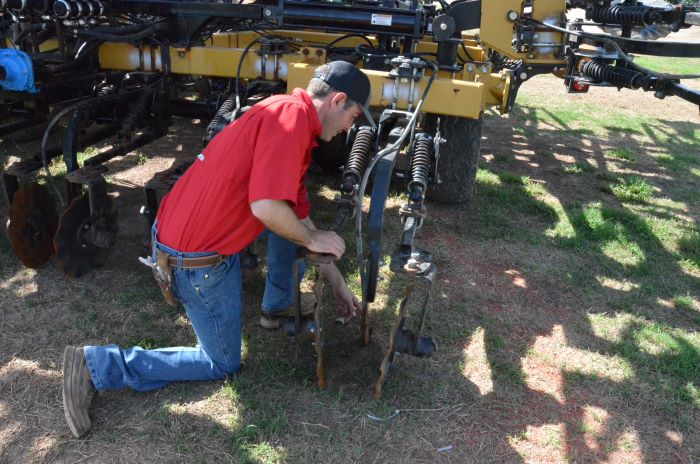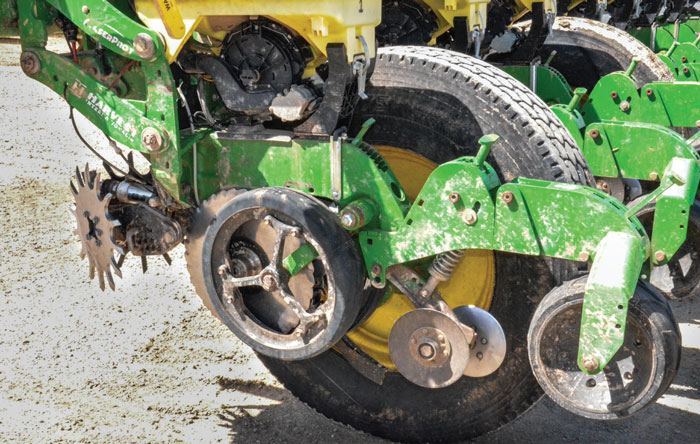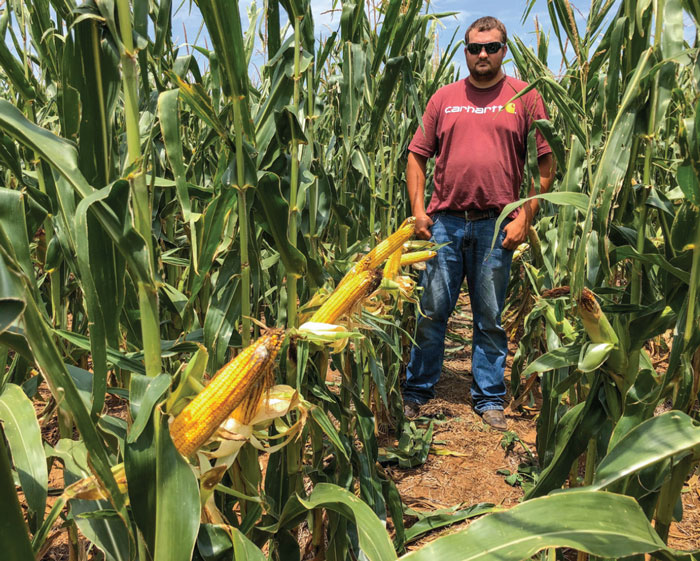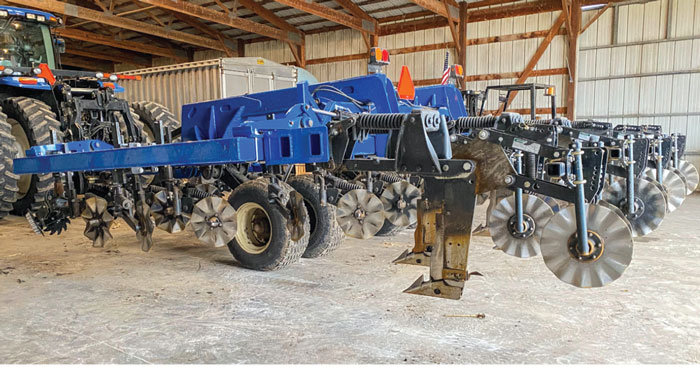Farming in tight, clay soils in northern Oklahoma where rains can be as fickle as a politician’s promise has made the Schnaithman family confirmed strip-tillers for their corn and soybeans. They’ll be the first to tell you that the Southern Plains are NOT the Corn Belt.
Travis and Tyler Schnaithman, and their father, Lee, were primarily no-tillers on their cash-grain and cattle operation, which spreads over about 15 miles in eastern Garfield County just west of I-35 on the road to Enid. They were protecting the soil, but because of the area’s unpredictable late winter and early spring rains, corn emergence uniformity wasn’t acceptable.
While they’re still at the mercy of Oklahoma’s erratic weather, 9 years of strip-till and some regularly planned disruptive in-line ripping to break up their clay soil’s natural tendency to compress, they now enjoy more yield consistency in their winter wheat, corn and soybean rotation. Also, regular applications of poultry litter and systematic liming have helped them boost organic matter in their fields from the 1-1.5% average found on surrounding farms to 2.5%.
“The soil is our foundation, so we have to have a long-term strategy…”
“The soil is our foundation, so we have to have a long-term strategy,” Travis says. “The farming enterprise represents about 75% of our acreage and adopting strip-till with regular in-line ripping, along with manure incorporation, has definitely helped us grow our returns.”
Strip-Till Switch
The Schnaithmans adopted strip-till in 2015 after several seasons of watching neighbors experimenting with the practice and a trip to the National Strip-Tillage Conference, where they met Kevin Kimberley, an independent Iowa-based consultant who has worked with them each year since. Their first strip-till rig was a 12-row Wako, but as their farm and their comfort level with strip-till grew, they upgraded to a 24-row Wako.
Overall, Schnaithman says it’s difficult to pinpoint their system’s yield increases given the “feast or famine” rainfall patterns recently.
“It can range from 10 to 15 bushels to 3 bushels,” he says.
Still, with the 50/50 wheat and corn rotation with double-crop beans adding a third harvest over 2 years, they’re pleased with the results, but they are always trying to improve.
With a yield goal of 125 bushels per acre for dryland corn, the Schnaithmans see 100-plus bushels when rains cooperate. Double-crop soybeans average between 20-40 bushels, but even when drought drives them into single digits, they earn their keep maintaining rotational weed control. Winter wheat ranges from 60-70 bushels in good years.
“If dry weather fails one part of the rotation, the next is cocked and ready to go when it does rain…”
“Even in a very dry year, we’ll get at least 25 inches of moisture, but we never know when it might come,” he says. “With our rotation, we try to cover our bets. If dry weather fails one part of the rotation, the next is cocked and ready to go when it does rain.”
He says home runs are rare, but the diversity of the rotation and strip-till and planting technology even out the farm’s performance.
The scale of Schnaithman Farms is large and spread out. Input costs are significant, but the family views those expenses as the cost of doing business.

Travis Schnaithman points out the mole-knife mounted on a spring-loaded flexible shank at the tail end of his family’s strip-till machine. Note the liquid fertilizer tube running near the shank used for in-strip nitrogen application. Photo by Dan Crummett
“Systematic liming is expensive, but we’re working hard to get calcium and magnesium levels in balance,” Travis says. “Also, in-line ripping is expensive in fuel, time, machinery wear and depreciation, but because we plant on the same line as we rip it, gives us better root development by reducing compaction and fosters a zone for better root development. Plus, it improves water catchment below the plants to help us get through frequent periods of drought.”
The Tools
Schnaithman Farms runs a beefy, locally produced 24-row Wako 190G Big Country strip-tiller set on 30-inch rows. A 500 hp. John Deere 9570 RX provides the muscle.
The Wako is equipped with a 3-coulter system up front to prepare the soil for the ground-engaging knife and canted disks, which form a 4- to 6-inch berm, depending upon conditions. The knife is mounted on a heavy spring-loaded flexible shank, which helps shatter soil in the strip and move clods or rocks in its path. The system was designed by Kimberley for Wako.
Kimberley says the design works well in a variety of soils and explains the sizing of the width and depth of the mini-mole knife, or a skinny knife in some conditions, is a key to the system’s performance across the Great Plains. Used in conjunction with off-set rippers, he says many growers have consistently seen yield increases.
“I know growers working in soils similar to what the Schnaithmans farm who have seen a 22-bushel corn boost combining strip-till with off-set inline ripping,” Kimberley says.
Schnaithman says building strips usually begins shortly after New Year’s Day on their farm and continues through mid-March corn planting, sometimes with their 24-row John Deere 1770 planter running just behind the Wako.

The Schnaithmans run a pair of 24-row John Deere 1770 planters equipped with Yetter row cleaners, STP openers for corn, and 3-inch gauge wheels running beneath Harvest International parallel linkage arms. A Yetter closing system brings up the rear. Photo by Dan Crummett
“We usually want at least 24-48 hours minimum between strip building and planting, but sometimes nature forces us into tailgating in the field,” he says.
The early spring-built berms running 8-inches deep typically allow a mellow soil for planting when conditions cooperate, and because the Wako is equipped with a liquid fertilizer system and John Deere rate controller, it also applies half of the corn yield goal nitrogen (N) rate in the form of 28-0-0-5 to await the planter. The remainder is applied pre-emerge on a weed and feed application, along with a pop-up application dribbled on at planting.
A 60-foot Rogator applies variable-rate phosphorus (P) and potassium (K) on the farm each season as part of the operation’s overall nutrient management, based on regularly monitored 2.5-acre grid sampling.
The Schnaithmans typically market some of their grain in northeastern Oklahoma to terminals on the McClellan-Kerr Navigation System, using backhaul loads of eastern Oklahoma poultry litter to build their soil organic matter.

Kole Kimberley (consultant team) demonstrates consistent ear height on Schnaithman’s corn achieved with in-line ripping, the three-coulter strip-till system, and lots of aftermarket planter tweaking in the family’s heavy clay corn fields. Photo by Kimberley Ag and Consulting
Their two planters are equipped with Precision Planting CleanSweep and DeltaForce, along with Yetter row cleaners, STP openers for corn, and a Wear Parts disc opener for double-crop soybeans. Also, they run 3-inch gauge wheels, Harvest International parallel linkage arms and a Yetter closing system. Kimberley says the combination has proven very effective for improving uniform stand-emergence across the country.
The Ripper
“We use a John Deere ripper,” Travis says, “But this past year it was too wet to rip. We’d just smear the soil, so we opted to stay out of the field with the ripper.”
Generally, he says ripping 12-14 inches deep is a regular part of the operation with at least 25% of the farm ripped every 2 years.
“I know growers who have seen a 22-bushel corn boost combining strip-till with off-set inline ripping…”
“Besides the root column improvement it provides, we’re steadily making progress on our compaction issues,” he says. “Kevin tells us the key is to run the ripper shanks vertical and to offset them. Every other shank offset 20 inches. Otherwise, if all the ripper shanks are aligned across the machine, it lifts all the soil simultaneously and blows out the soil structure across the width of the machine.”

This Blu-Jet mounted deep ripper shows the vertical orientation and 20-inch offset of ripper shanks Kevin Kimberley says is necessary to work heavy clays for strip-till success. Photo by Kimberley Ag and Consulting
By staggering the ripper shanks, soil structure is maintained either side of the leading shanks, and that allows an important solid surface to remain between rows. In the row, however, the soil can mellow and provide a better environment for plant development and moisture conservation.
Kimberley uses his “ice cube theory” to explain the benefits of leaving the integrity of soil structure intact adjacent to each ripper shank.
“You can pack crushed ice, but you can’t pack ice cubes,” he says. “The stable soil structure left between off-set ripper grooves is like ice cubes, firm and solid, in the row, however, the shank destroys packed soil structure in a narrow band and the walls of that groove can crumble into a better medium for crop growth.”
Kimberley cautions ripping in wet soils smears the sidewalls and defeats the purpose and potential benefits of judicious ripping.
As a close observer of the conditions in which the Schnaithmans farm, Kimberley echoes Travis’ sentiments that some things like weather and markets are out of the farmer’s hands. “You only get to farm so many seasons in your life, so do everything you can to stack the odds in your favor, though the Good Lord is still in control,” he says.







